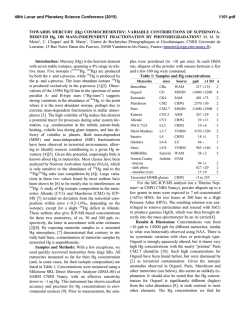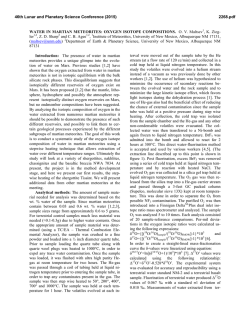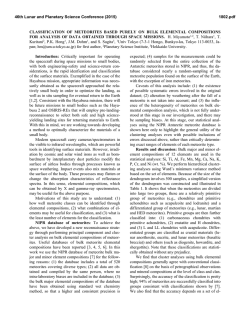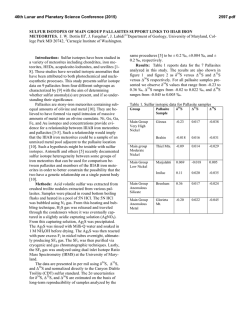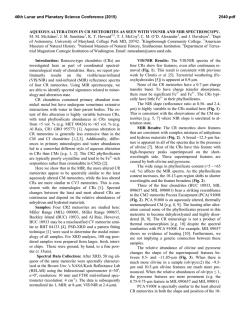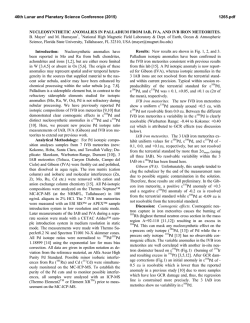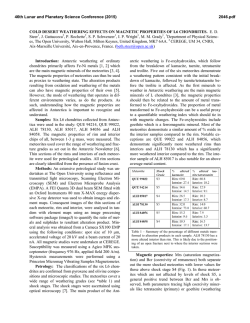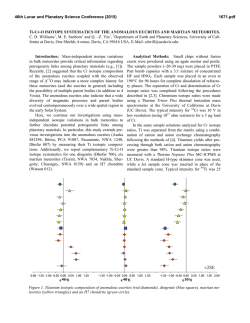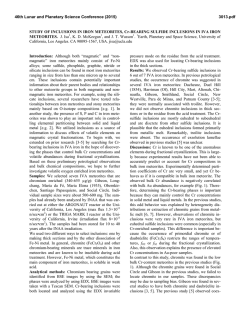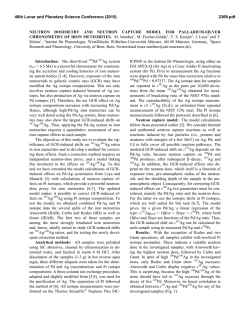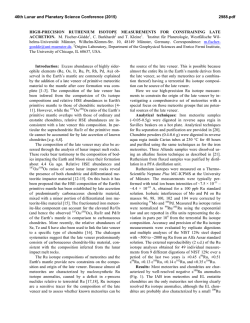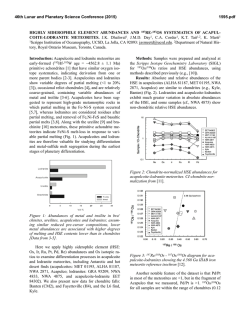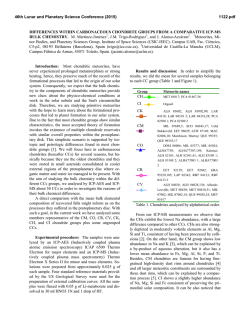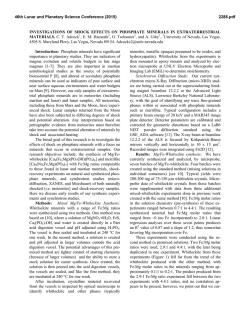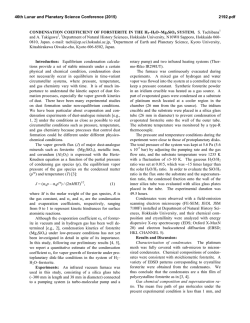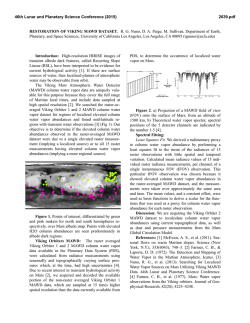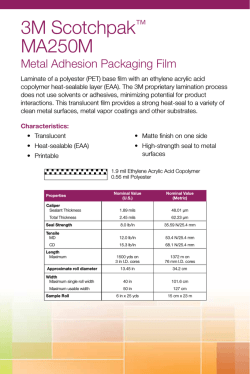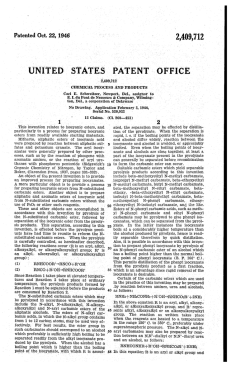
1839
46th Lunar and Planetary Science Conference (2015) 1839.pdf PECULIARITIES OF ORGANIC MATTER FORMATION IN IMPACT-INDUCED VAPOR PLUME. M. V. Gerasimov, M. A. Zaitsev, E. N. Safonova, Space Research Institute of the Russian Academy of Science, Profsoyuznaya, 84/32, Moscow, 117997, Russia, [email protected] Introduction: Organic compounds (OC) can be produced by various natural processes and can be found in interstellar clouds, meteorites, comets, planets, etc. An impact of a meteorite into the Earth is generally considered as destructive process for organics because of the action of two factors: 1) extremely high temperatures, and 2) oxidizing conditions in the forming plume due to thermal dissociation of silicates. There is a possibility that some portions in rare side of an impacting body can experience reduced shock wave loading [1] and imbedded organic components will survive the impact. It was shown experimentally that even original microorganisms can survive shock loading at ~40 GPa [e.g., 2]. The present paper considers the possibility of synthesis of organic species from initially inorganic and/or organic CHONS elements during impact-induced vaporization of silicates. Formation of complex molecules in an impactinduced vapor processing occur through a quick quasiequilibration at a high-pressure and high-temperature stage with a quenching at a certain expansion of the plume. Equilibration stage implies certain requirements on the chemical composition of the system when natural impacts are modeled. It is well known that reducing conditions favors synthesis of complex OC [3]. The use of a formamide target provides impactsimulated formation of important nucleobases [4]. It is important to note here that the specific feature of chemical conditions during impact-induced evaporation of silicates is the substantial concentration of molecular and elemental oxygen in the vapor cloud which is formed due to thermal decomposition of petrogenic oxides [5]. The estimates show that partial pressure of free oxygen can be as high as one third of the vapor pressure [6]. During the vapor cloud expansion and cooling, oxygen is almost completely consumed for the formation of condensed silicates, but it strongly affect the survivability of starting OC in the impacting material. Chemical composition of an impact-generated vapor cloud is formed under dissociation and recombination processes. Gas mixtures that are forming at such conditions contain both oxidized and reduced components and are in disequilibrium when intrude normal environmental conditions. It was shown experimentally that the formed gases simultaneously contain sufficient quantities of H2 and O2, SO2 and H2S, CO2 and CH4 [6]. The most abundant reduced gases in quenched mixtures were H2, H2S, CH4, and light hydrocarbons up to C6H6 [7]. Coexistence of O2 and H2 in high temperature silicate vapors is supported by thermodynamic calculations. The analysis of the shock mechanism indicates that, almost in the whole range of planetologically important impact velocities, we deal with the partial evaporation of silicate materials, and expansion of an impact-generated cloud proceeds in accordance with the condensation law [8]. This means that all molecules in the cloud continuously interact with the condensed particles. The particles have submicron size and therefore they provide good conditions for surface reactions. The amount of formed organic species is orders of magnitude higher than that predicted by gas phase thermodynamic equilibrium [6]. We claim that heterogeneous catalysis on the surface of condensed particles is the main mechanism of OC synthesis in the spreading cloud. The possible mechanism here can be the Fischer-Tropsch-type of synthesis since CO and H2 are abundant molecules among C- and H-bearing components. Organic species were mainly highly polymerized hydrocarbons with low solubility in solvents. It seems that polymerization into kerogen-like staff is the main trend that provides survivability of organics at harsh conditions of the vapor plume. Additional factor favoring the synthesis of OM on the surface of condensed particles is the possible catalytic activity due to the presence of nano-meter particles of reduced iron and other siderophile elements. They are formed from petrogenic oxides as a result of thermal reduction and immiscibility of the metallic phase [9,10]. Iron is present in the forming condensate as Fe0, Fe+2, and Fe+3 reflecting complex redox processes in the vapor. The main rock-forming element, silicon, has also complex redox behavior and was detected in Si0, Si+2, and Si+4 states [11]. Experiment: The aim of the experiment was to investigate the transformation of original organics of two carbonaceous chondrites - Murchison (CM2) and Kainsaz (CO3) - due to impact-evaporative processing. Our simulation experiments were performed using standard laser pulse (LP) technique [8]. The chamber during laser ablation of meteorites was filled in some experiments by inert gas (helium) or by reducing gas (hydrogen) to see the response of the synthesis on change in redox conditions. Comparative study of original OC in the meteorites and in condensed products of the simulated impact-induced evaporation of these meteorites was done using pyrolytic gas chromatography coupled with mass spectrometry (Pyr- 46th Lunar and Planetary Science Conference (2015) GC/MS) technique. We performed two-step pyrolysis (460°C, 15 min → 900°C, 10 min) under helium flow of pulverized meteorites (20 mg) and solid condensates (25 mg) from 2-3 LP experiments. The released volatiles were collected at temperature of liquid N2 and then desorbed into the chromatographic system by pulse heating of the cryogenic trap up to ~400°C. Results and Discussion: We found significant differences in the composition and ratios of volatile organics between pyrolysates (at 460°C) of meteorites and their condensates obtained at different conditions. All condensates gave lesser absolute amounts of OC during pyrolysis then the initial meteorites. The“hydrogen” condensates gave significantly higher amounts of volatiles than the “helium” condensates. The “helium” condensates gave volatiles which have higher relative amounts of N-, S-containing compounds and aliphatic hydrocarbons then the starting meteorites and large amounts of CO2 and SO2. The “hydrogen” condensates gave OC containing higher relative amounts of aromatic and alkyl-aromatic hydrocarbons compared to the starting meteorites. At the same time, S-containing OC were almost absent, but there were huge amounts of H2S. Residual pyrolysis of all of the condensates at 900°C gave only carbon dioxide, sulfur dioxide, benzene and traces of other aromatics. The Murchison bulk material had higher abundance and diversity of OC in pyrolysates than the Kainsaz. Nevertheless, the condensates of the Kainsaz (both “hydrogen” and “helium”) were much higher in diversity and quantity of volatile organics than the Murchison condensates and gave lesser amounts of CO2 and SO2. Processed meteorites have different metamorphic degree and volatile elements content. Nevertheless, they show rather similar OC pattern (fig.1) for the same redox conditions in the experiment. This phenomenon can be explained by formation of quasiequilibrium compositions under similar redox situation. General similarity of OC patterns for starting meteorites also can be related to similar redox conditions in the region of formation of these meteorites. The differences in OC pattern for the condensates of both meteorites obtained at the same redox environment can be a result of the difference in elemental and mineral composition of meteoritic materials. The higher diversity in OC of the Kainsaz condensates can be a result that the Kainsaz is more reduced than the Murchison. It contains ~5% vol. of nickel iron [12] compared to <0.5% vol. of the same in Murchison [13]. The possible indicator of Fisher-Tropsch reactions is the releasing of n-alkanes and long-chain alkyl-aromatic hydrocarbons from the condensates dur- 1839.pdf ing pyrolysis. Especially it is related to the Kainsaz condensates. Fig.1. Relative abundances of different groups of volatile OC in pyrolysates (460 °C) of bulk Murchison and Kainsaz and their condensates obtained in helium and hydrogen atmospheres. Acknowledgment: This research was supported by the RAS Program of Basic Research (P-9). References: [1] Pierazzo, E. and Melosh, H. J. (2000) Meteoritics Planet. Sci., 35, 117-130. [2] Misgaiski M. et al. (2007) LPS XXXVIII, CDROM, #1286. [3] Urey, H. and Moller, S. L. Science 130, 245-251, 1959 [4] M. Ferus et al. (2014) PNAS, www.pnas.org/cgi/doi/10.1073/pnas.1412072111. [5] Gerasimov, M. V. et al. (1984) Dokl. Akad. Nauk SSSR, 275, No. 3, 646–650 (in Russ.). [6] Gerasimov, M. V. (2002) In: Catastrophic Events and Mass Extinctions: Impacts and Beyond, Koeberl, C., and MacLeod, K. G., eds., GSA Special Paper 356, 705-716. [7] Mukhin, L. M. et al. (1989) Nature, 340, 46-48. [8] Gerasimov, M. V. et al. (1999) Physics and Chemistry of Impacts. In: Laboratory Astrophysics and Space Research, P. Ehrenfreund et al. (eds.) KAP, 279-329. [9] Yakovlev, O. I. et al. (1992) Geokhimiya, No. 12, 1359–1370. [10]Yakovlev, O. I. et al. (2009) Geochem. Int., 47, 134–142. [11] Yakovlev, O. I. et al. (1993) Geochem. Int., 30, 1-10. [12] McSween H.Y. (1977) Geochim. Cosmochim. Acta, 41, 477-491. [13] McSween H.Y. (1979) Geochim. Cosmochim. Acta, 43, 1761-1770.
© Copyright 2026
